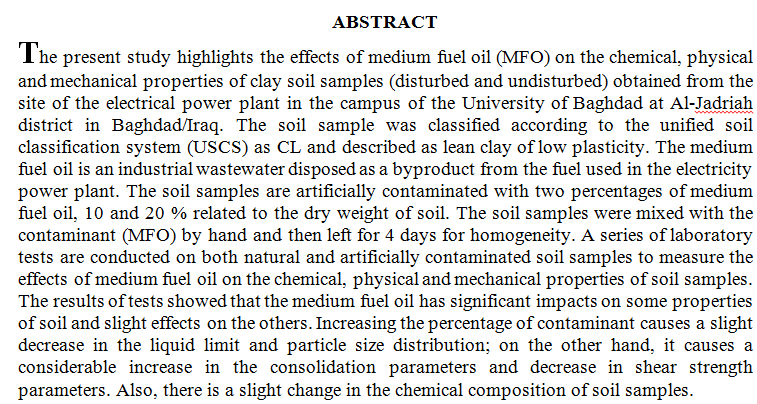
This research dealt with desalting of East Baghdad crude oil using pellets of either anionic, PVC, quartz, PE, PP or
nonionic at different temperature ranging from 30 to 80 °C, pH from 6 to 8, time from 2 to 20 minutes, volume percent
washing water from 5 to 25% and fluid velocity from 0.5 to 0.8 m/s under voltage from 2 to 6 kV and / or using additives
such as alkyl benzene sulphonate or sodium stearate. The optimum conditions and materials were reported to remove
most of water from East Baghdad wet crude oil.
جريت التجربة في اصص فخارية سعة كل اصيص 4 كغم تربة في البيت الزجاجي التابع لقسم علوم الحياة/كلية التربية ابن الهيثـــــــــم/جـامعــة بـغداد لموســم النمـو 2008-2009 لدراســة تأثيــر اربعـــة مستويـــــات من سمــــاد اليوريـــا وهي (0, 0.1, 0.2, 0.4) غم/اصيص والتي تعادل (0, 100, 200, 400) كغم/هكتار وثلاث مستويات من سماد السوبر فوسفات وهي (0, 0.1, 0.2) غم/اصيص والتي تعادل (0, 100, 200) كغم/هكتارفي مكونـات الحاصـــل لنبــات الحلبـــة Trigonella foe
... Show MoreThe research problem revolves around the failure of Maysan Oil Company to have a strategy that enables it to keep up with work in a mysterious and highly dynamic environment. Therefore, the research aims to present a proposed strategy that is comprehensive and realistic to the Maysan Oil Company for the next five years (2020-2024) based on the position and conditions of the company Current and future by adopting the scientific foundations for formulating the strategy, and the importance of research lies in the company's situational analysis to know its internal capabilities from strengths or weaknesses and diagnosing the surrounding elements of opportunities or threats so that this analysis represents a s
... Show MoreOil sector is one of the most important sectors affecting the ecological balance, as activity contributes to the oil companies to influence their working environment, both during the oil exploration and extraction process or during transfer from one place to another process. We will try through this research put an environmental audit program proposal takes into account all the financial aspects, commitment and performance, according to the laws and regulations and agreements as well as relevant international standards, was based on research on the premise that the development of an environmental proposal auditing program that includes environmental controls on oil industry phases which helps reduce or minimize environmental pollutants B
... Show MoreUranium concentrations in soil were determined for ten locations in Salahdin governorate using CR-39 track detector, fission fragments track technique was used, the nuclear reaction of nuclear fission fragments obtained by the bombardment of 235U with thermal neutrons from (Am-Be) neutron source with flux (5000n.cm-2.s-1), the concentration values were calculated by a comparison with standard samples. The results of the measurements show that the uranium concentration in soil samples various from 0.42±0.018ppm in Beji province to 0.2±0.014 ppm in Tooz province with an average (0.31±0.08ppm), the values of uranium concentration in all samples are within the permissible limits universally.
 (6)
(6)
 (6)
(6)
 (1)
(1)
A laboratory investigation of six different tests were conducted on silty clay soil spiked with lead in concentrations of 1500 mg/kg. A constant DC voltage gradient of 1 V/cm was applied for all these tests with duration of 7 days remediation process for each test. Different purging solutions and addition configurations, i.e. injection wells, were investigated experimentally to enhance the removal of lead from Iraqi soil during electro-kinetic remediation process. The experimental results showed that the overall removal efficiency of lead for tests conducted with distilled water, 0.1 M acetic acid, 0.2 M EDTA and 1 M ammonium citrate as the purging solutions were equal to 18 %, 37 %, 42 %, and 29 %, respectively. H
... Show More (26)
(26)
 (22)
(22)
The current research aims to determine the extent of the impact of the strategic direction to the business process reengineering, in the Office of the Ministry of Oil To reach that goal was a sample of community research study consisted (50) members of the senior leadership represent the problem in organization researched in the ambiguity of the strategic direction of knowledge of the compatibility of the strategic direction with Business Process Reengineering and used questionnaire, interview and observation to obtain the information needed to search was addressing data by the statistical system spss percentage and the arithmetic mean, standard deviation and coefficient of variation .
... Show More